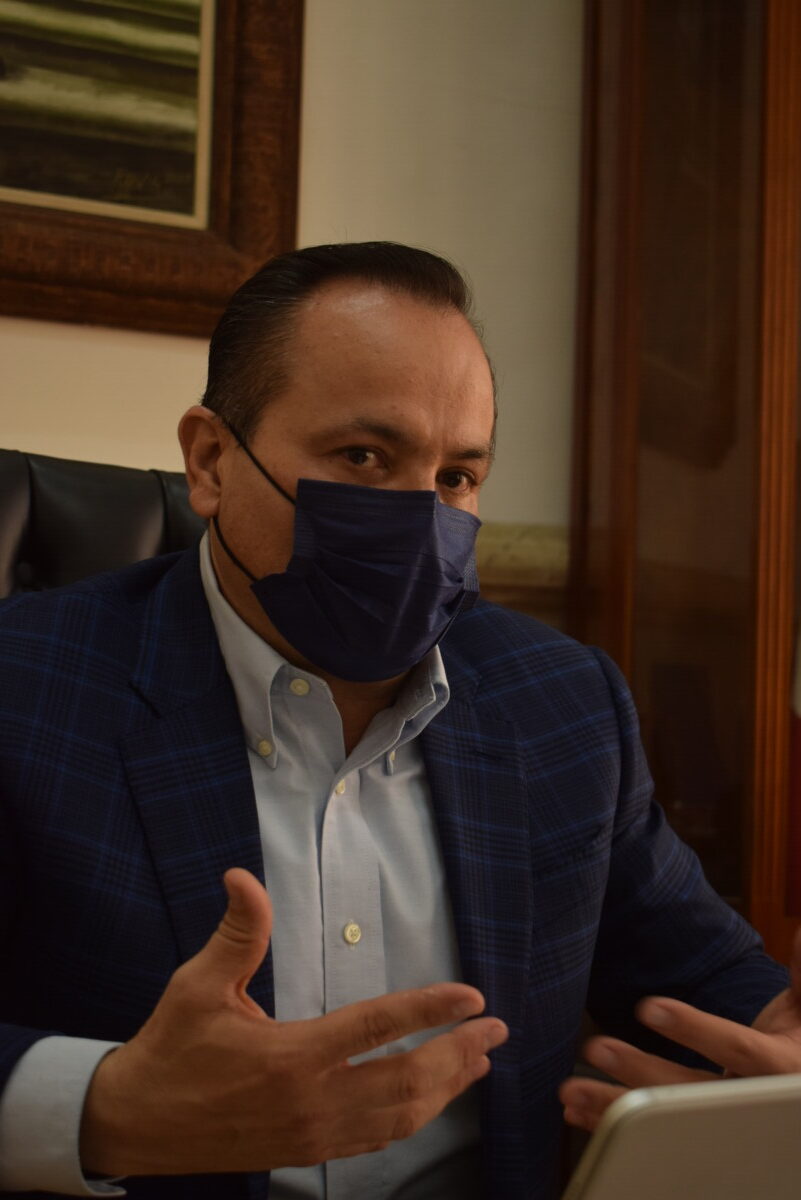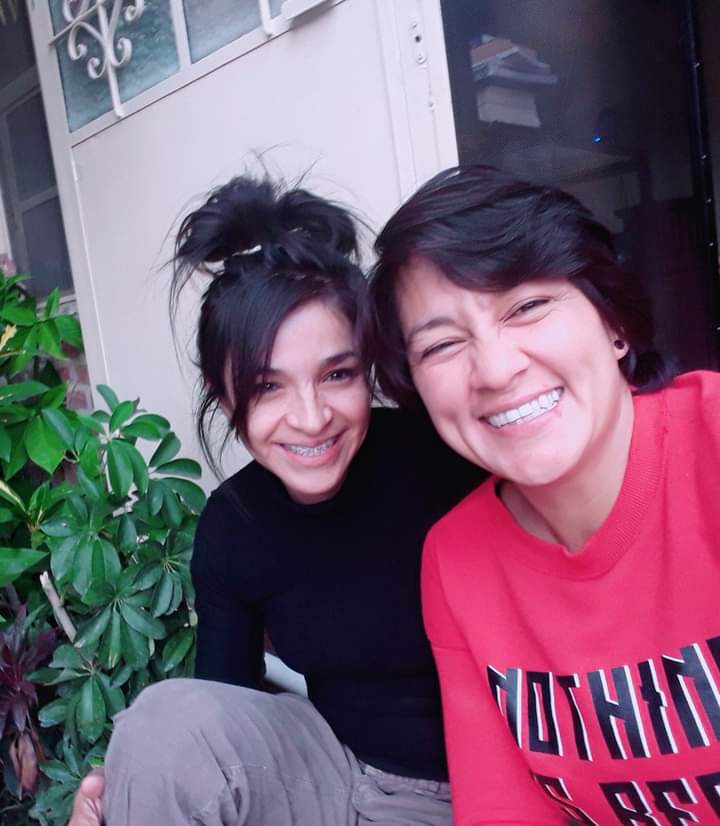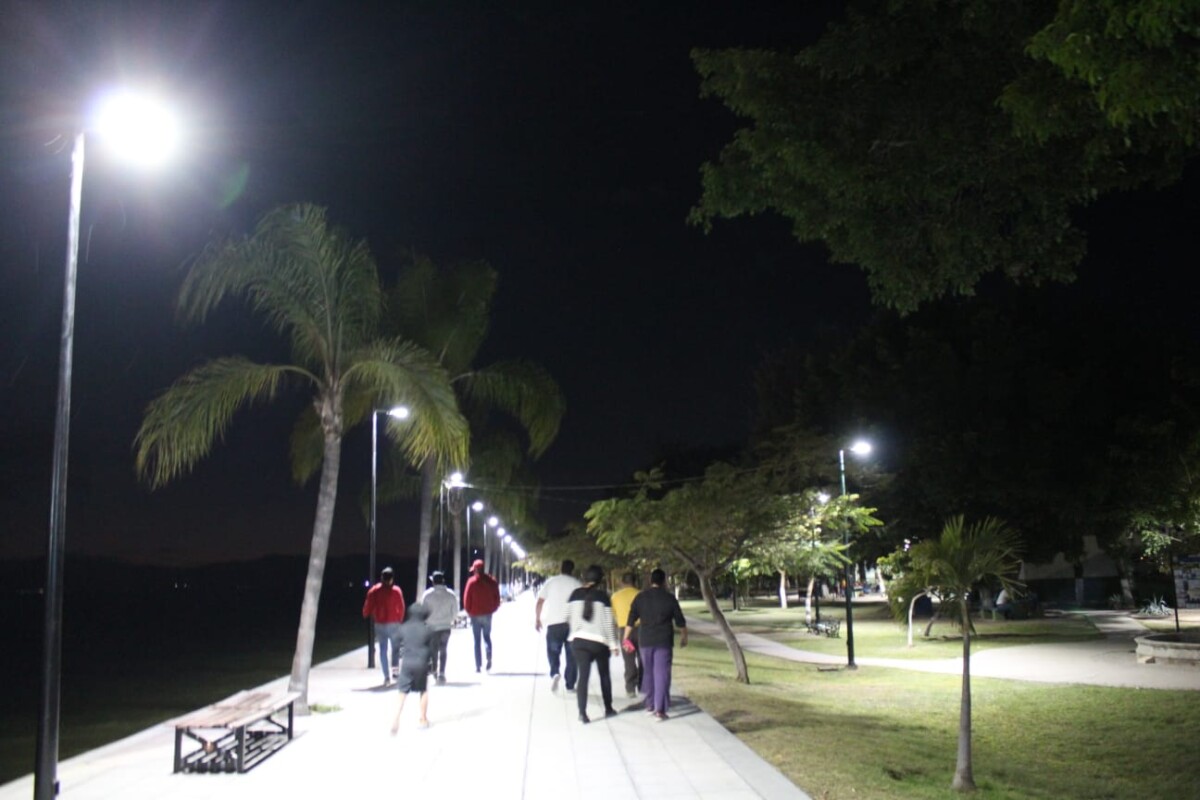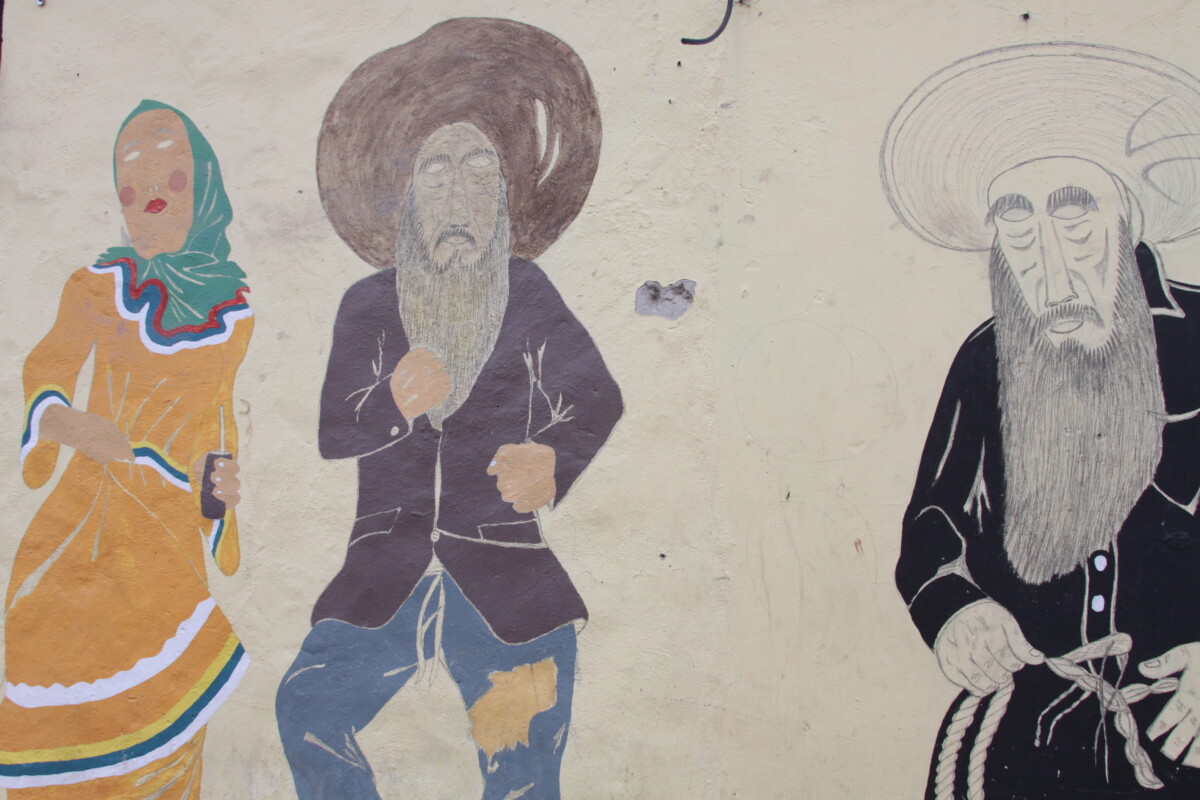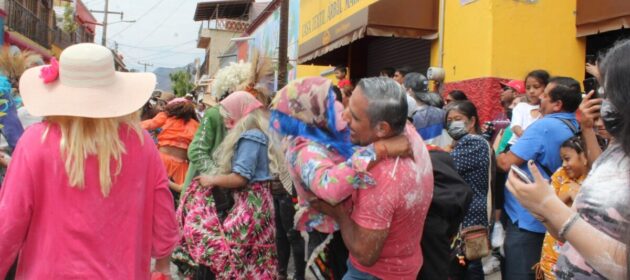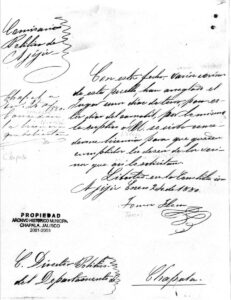Ajijic
The opening of formerly privatized streets in Chapala will continue
Alejando de Jesús Aguirre Curiel during an interview in his presidential office.
Jazmín Stengel (Chapala).– The campaign to recover public spaces will continue, declared Alejandro de Jesús Aguirre Curiel, president of Chapala, during an interview with the media on February 15.
When questioned by this reporter about whether the opening of privatized streets will happen in other subdivisions of the municipality, the mayor said that work is already being done in this regard. «As you have seen, we have already been working on it and we will continue,» he announced.
The first reopening of closed streets occurred in the Mirasol subdivision. This change provoked discontent from the subdivision’s residents. Aguirre Curiel reiterated that these streets will remain open, «The streets have to be open because the population of the area has grown.»
«The growth of the population is with its streets,» said the president, adding that the campaign to recover public spaces will not stop, as promised during my political campaign.
The authorities did not provide specific data on which streets will be reopened, nor how many subdivisions are in the same situation as Mirasol before this report went to press.
Translated by Nita Rudy
Weekend traffic in Ajijic jams highway and streets
Traffic on the Chapala-Jocotepec highway, near Rancho del Oro, in Ajijic. Photo: Sofía Medeles
Sofía Medeles (Ajijic).– In the last few weeks, traffic saturation on the Chapala-Jocotepec highway, at the height of Ajijic, as well as its streets, especially Ocampo, has been increasingly noticeable. This situation is changing from a holiday problem into a daily one, making it difficult for those who live in the town to use their cars.
On Sunday the 13th and Monday the 14th, there were lines of cars from San Juan Cosalá, due to the accident on the Guadalajara-Morelia highway at the intersection of El Molino, in Jocotepec. This accident caused cars to take up to 50 minutes to drive the three kilometers through Ajijic, also congesting Ocampo Street while it was used as an alternate route.
Although the traffic is not always this heavy, several drivers in the town said that it is increasingly difficult to drive in Ajjic, especially during rush hour.
«Normally, from two o’clock in the afternoon until four o’clock, the road fills up with cars from La Floresta and traffic starts to become lighter in Villa Nova (in Chapala). The problem occurs in La Floresta, where everyone starts to use the side roads, and they jam traffic. Then on Ocampo and Guadalupe Victoria, there is also a traffic jam, not to mention on Colón. I don’t know where so many cars come from and I don’t see a solution to the problem,» said Luis, a resident of Ajijic.
Another native of the town, Antonio, commented that some years ago these were problems that were only seen on vacations or when there were festivities, but since Ajijic was declared a Magic Town, it began to become a daily occurrence.
«On a Tuesday or Thursday, it has taken me up to 40 minutes to get through Ajijic. During rush hour they should assign traffic cops because there is no lack of visitors who want to go the wrong way on a street, just to get around the traffic on the highway. It happens a lot on Zaragoza Street, around Six Corners, and they don’t go slowly, they go very fast.»
Fany, a pedestrian in the area, confirmed that cars coming down to avoid traffic usually go at high speed. She said, «The children here on the block go out to play, plus there are several dogs. Cars going very fast don’t stop to see who might be trying to cross, they just think they are going down the road. They say that the traffic jam is due to the traffic lights not being synchronized, and if that is the case, the authorities should intervene quickly. Because it is not only the traffic, it can cause harm to the people who walk on the street.”
The director of Social Communication of Chapala, Elizabeth Oropeza Silva, commented that since the highway is a state highway, they haven’t asked for support from the State Government, for more police crs and traffic police. She also ruled out that the problem is due to the traffic lights, since they were maintained and synchronized at the end of the year.
Translated by Christalle Dalsted
Nina, the ‘miracle child’ embraced by Our Lady of Lourdes
Nina the first time she embraced Our Lady of Lourdes in front of her chapel. Photo: Daniel Padilla.
Jazmín Stengel (Chapala).- Twelve year-old Nina Yocelin Martínez Flores, daughter of Mara de Lourdes Flores López and Diego Ernesto Martínez Jiménez is considered the miracle of the year in the Lourdes neighborhood Chapala.
The teenager was diagnosed with leukemia in 2019. «It was a very serious situation, we did not know what to do about it,» said Diego, the girl’s father. Being a very religious family, the parents began Nina’s treatments, but trusted their faith.
In spite of the desperation and how complicated it is to help a family member lying in a hospital bed, the Martínez Flores family received a lot of help. “Every time I arrived with my mother, the neighbors or relatives had left something to support us,» said Diego.
After a year of treatment, Nina was able to return home. Her father Diego, an active participant in the vigil of St. Francis of Assisi, asked permission to receive the statue of Our Lady of Lourdes and lay his daughter at the feet of the Virgin. Incredibly for all present «the Virgin embraced Nina,» commented neighbors after seeing Daniel Padilla’s photograph.
Nina says that on that day the Virgin, in her invocation of Our Lady of Lourdes, spoke to her as she went up and embraced her. She heard a clear voice that said «you are going to be cured, daughter, you are going to be cured». Although the parents were skeptical at first, the confidence that their daughter showed, made them believe.
It was not the only time something similar happened, in the last three years Nina’s parents have taken her to view the Virgin of Lourdes and St. Francis of Assisi. On more than one occasion the now teenager had unexplainable experiences, in which she claims to have heard voices or felt observed by the images in the temples.
After three years of continuous treatment, Nina Yocelin Martinez is stable. This miracle strengthens the faith of the neighbors of the Lourdes neighborhood. Although leukemia is a disease with regular relapses, the girl has not had any so far.
Translated by Christalle Dalsted
Mimi and Judo: a genuinely unconditional love
Mimi Martínez and Judo Zamora, both from Ajijic, have been in a relationship for just over four years.
Sofía Medeles (Ajijic).- This is the story of Noemi Milagros Martinez Romero – «Mimi» and Judith Reyes Zamora – «Judo,» two women who, despite the ups and downs of their relationship, have fought against rejection, discrimination and criticism to move forward together.
Although they were neighbors in their youth, they actually met just under five years ago when Judo moved into an apartment near Mimi’s current residence. In a short time, they went from sharing greetings to having coffee; after four months of living together, their friendship turned into love.
«I liked Judo and flirted with her, but since I have my family, she didn’t think I liked her. Love stirred during those four months of living together, visits and so on,» said Mimi.
The beginning of their romance was difficult mainly because of their families, but also due to the discriminatory comments of the people around them. «Family opinions played an important role. When my family found out, many turned away and didn’t accept it. It took time for them to agree with what I wanted,» Mimi said.
Judo added that her close ones also put a «but» in front of the relationship due to the fact that Mimi already had children, but the couple overcame the criticism. «Eventually, we decided that other people were not going to make us happy. The relationship is about us, no matter what other people think.»
Mimi stated that her priority was her children, who accepted their relationship in the best way, showing that the only thing that mattered to them was their mom’s happiness.
«It’s an easy relationship, but it’s hard in this case because I have a family. Judo not only deals with my personality, but also with the personalities and dynamic of the five of us. Judo has been very supportive, because she has always had a good friendship with my children. She has represented the figure that is missing in the family, and she is both their confidante and their support.»
In the middle of the pandemic they got engaged, but they wanted to be sure before getting married that they had taken steps to build a strong foundation for their future life.
«For us, marriage is a symbol that our relationship is afloat despite everything we have been through, as well as being a document that formalizes the relationship. It is important because it represents the union we have,» added Mimi.
They also reaffirmed their support for each other’s work. Judo, who owns Lucky Bar, said that Mimi had helped her decorate and often assists her in events. For her part, Mimi has her craft and gift business called Nahomi’s Mimi Craftmiss, for which Judo has always shown her unconditional support.
Finally, they had advice for those who wish to be happy: «If you start thinking about all the criticism, you will never move forward. But when you know what you want, you have no choice but to fight against the world for a time and then you will be at peace with your choice.»
Although the beginning of their romance was difficult because of «what people will say,» now they live their love in freedom and are already engaged.
«We are already in the 21st century. After the pandemic, we learned that there is no time to lose; we have to look for and fight for what makes us happy, no matter what people say. We must seek happiness and emotional balance, anything else is extra,» concluded Judo.
Marriage equality has been legal in Jalisco since 2016. More recently, the state no longer requires couples to file a protective lawsuit, and they can get married in any civil registry of the state.
Translated by Rebecca Zittle
Light bulbs replaced on on Ajijic malecon
70 new lamps light up Ajijic’s malecon. Photo: Sofía Medeles.
Sofía Medeles: Personnel from the Ajijic delegation replaced the bulbs of 70 streetlamps To improve illumination on the malecon.
The installation work, as well as the pruning of some trees, was carried out on Wednesday, February 16. The new bulbs are distributed between the walkway and La Amistad Park.

Delegation personnel carried out the installation last February 16 on the malecon. Photo: Sofía Medeles.
Maximiliano Macías Arceo, the acting delegate of Ajijic, stated that bulbs that were removed but still work will be placed in areas with lighting problems, such as Lázaro Cárdenas Street or La Canacinta neighborhood.
Translated by Sandy Britton
Lakeside Chronicles: The sayaco is the inner child
Front wall of the Romero Pérez brothers’ home is illustrated by masked Sayacos, created by Aarón, one of the brothers. Photo by: María del Refugio Reynozo Medina
María del Refugio Reynozo Medina (Ajijic).- José de Jesús Romero Pérez still has the first hermit-like sayaco mask he made 15 years ago. The dark brown, immobile, sharp face is made of copal, a wood that he brought from the hills. The hollows of the eyes and the slightly open mouth are decayed. The eyebrows, beard and straw-colored mustache are made of a fiber obtained from coffee sacks.
Making a mask can take José de Jesús about two and a half weeks, working in the afternoons after his usual workday. Although he does not make them for commercial purposes, the unique masks which bear his signature, can sell for up to three thousand pesos. The masks that depict women (sayacas) are colorful, with embossed or painted eyelashes and eyelids splashed with glitter. Once carved with a chisel, vinyl paint is used to outline the eyebrows, eyes and eyelashes. The lips and cheekbones are painted deep red circles.

Abel and José de Jesús Romero Pérez grew up watching the sayacos and chasing them in many celebrations. Photo by: María del Refugio Reynozo Medina
The male masks of the sayacos are made of natural light or brown wood, with long beards, bushy eyebrows and moustaches made of horsehair. Romero Pérez’s masks are instantly recognizable. The images flow, as he chisels each feature. A face will emerge unexpectedly from the wood. He knows perfectly well the type of wood needed to design each face. In addition to wood from the native copal tree, he uses native tecomaca wood, which is soft and light.
He has sold eight masks. Buyers do not necessarily wear them in parades. They are purchased by collectors as unique pieces, inspired by the sayacos.
The Romero Pérez brothers Abel, José de Jesús, Gaspar, José, Aarón and Modesto, each year transform themselves into sayacos mainly to inaugurate the carnival. They also attend other celebrations throughout the year.
On a wall outside their home there is an unfinished mural painting drawn by Aarón. The image shows a dancing female sayaca dancing wearing a yellow dress trimmed with colored ribbon and brown booties, accompanied by two male sayacos. One is dancing wearing a brown jacket, denim pants and booties. The other sayaco has a black dress with white dowels as buttons. All of them have long faces, although their appearance in the parades brings smiles and laughter.
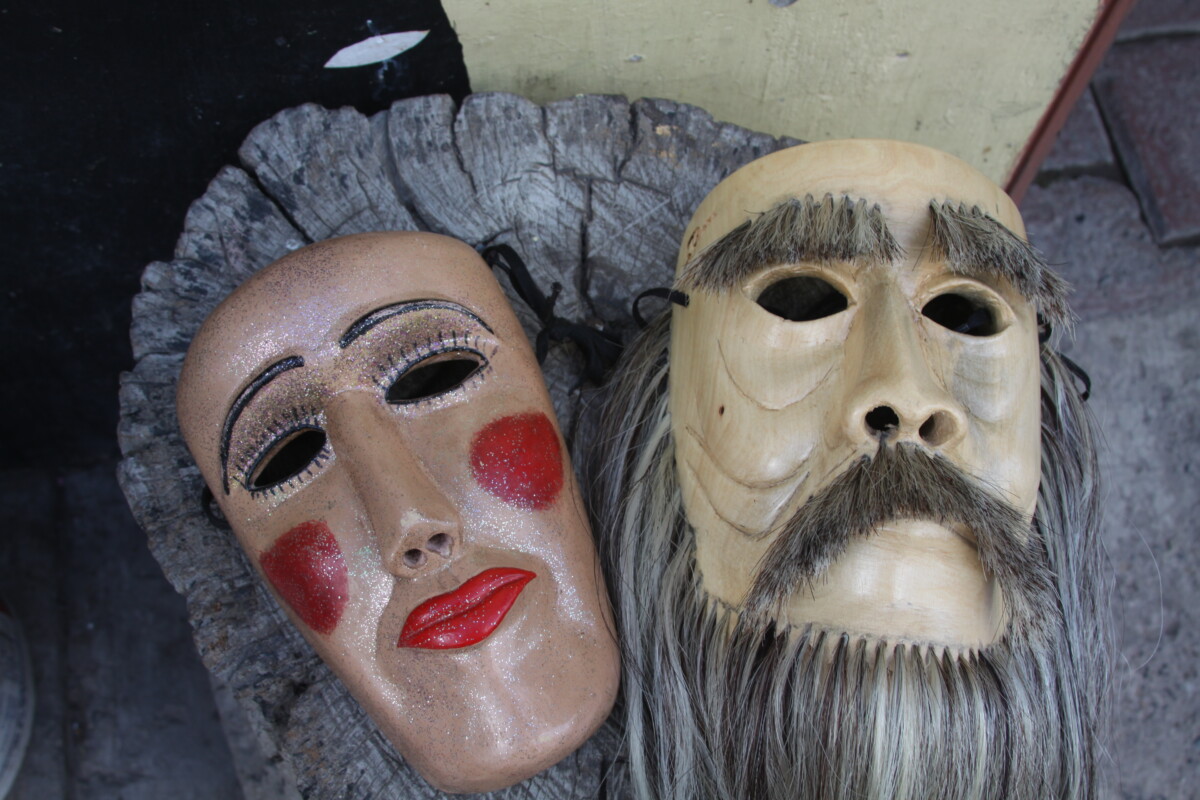
With copal or tecomaca wood, the masks made by Jesús Romero are unique pieces. Photo by: María del Refugio Reynozo Medina
“The sayaco is a very old character in the life of the people of Ajijic”, says Abel. They used to be called sayacal. Now they are called sayacas and sayacos. It is that mocking character that appears mainly in the carnival. They throw confetti and sometimes flour. Sometimes the flour is delicately smeared on their cheeks.
One of the main dances of the sayacos is called the dance of the «papaqui» which is accompanied by wind instruments. Sometimes they are invited to perform their dances at weddings or quinceañeras, the celebration of a girl’s 15th birthday. Abel remembers as a child watching the sayacos in the daily festivities. He and his siblings would race through the cobblestone streets following and teasing the sayacos amidst happy laughter.
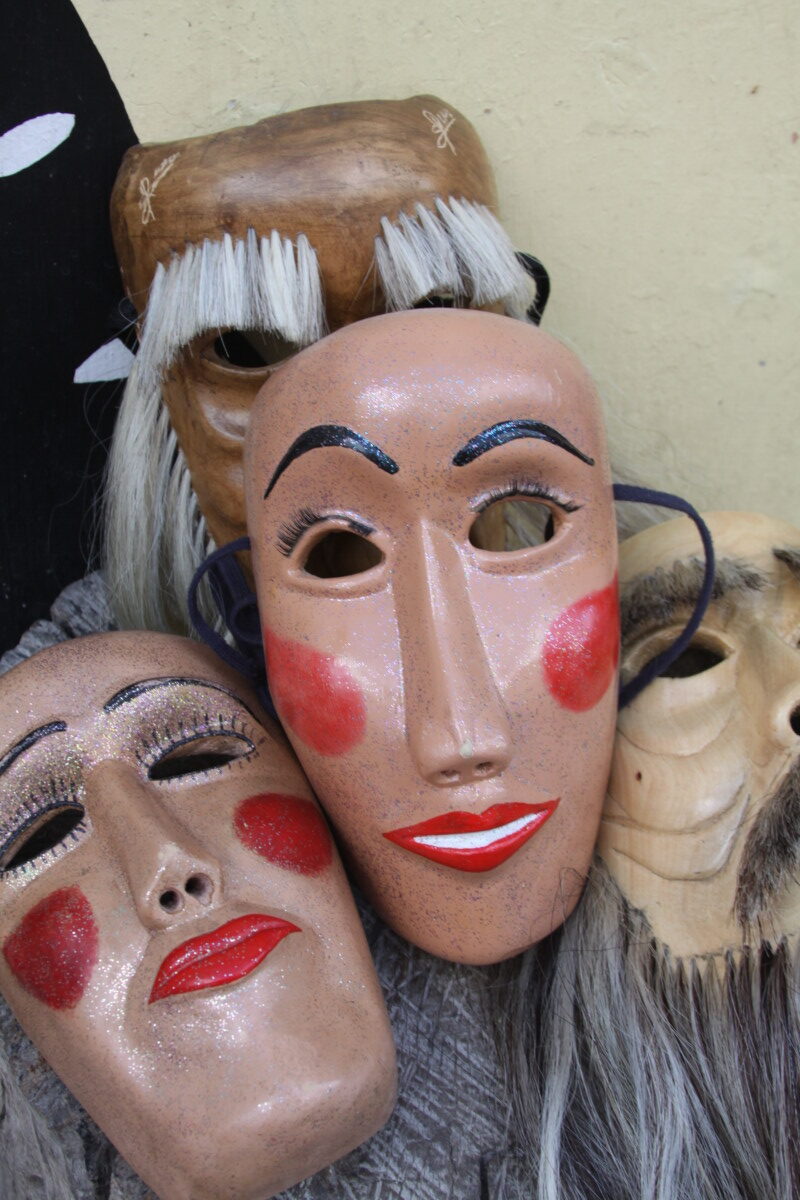
The masks of Jesus Romero Perez stamped with his signature can be worth up to three thousand pesos. Photo by: María del Refugio Reynozo Medina
The carnival parade is open to the entire population and a diversity of characters appear. The traditional attire is wooden or papier-mâché masks, sacks, shirts with dowels, booties, and hats. The sayacas wear bright printed dresses.
There is pride in being a sayaco. It is a nice, mocking, very old character who makes people laugh. The sayacos are mainly men. Even the sayacas are usually men because of the pushing, shoving, brawling atmosphere.
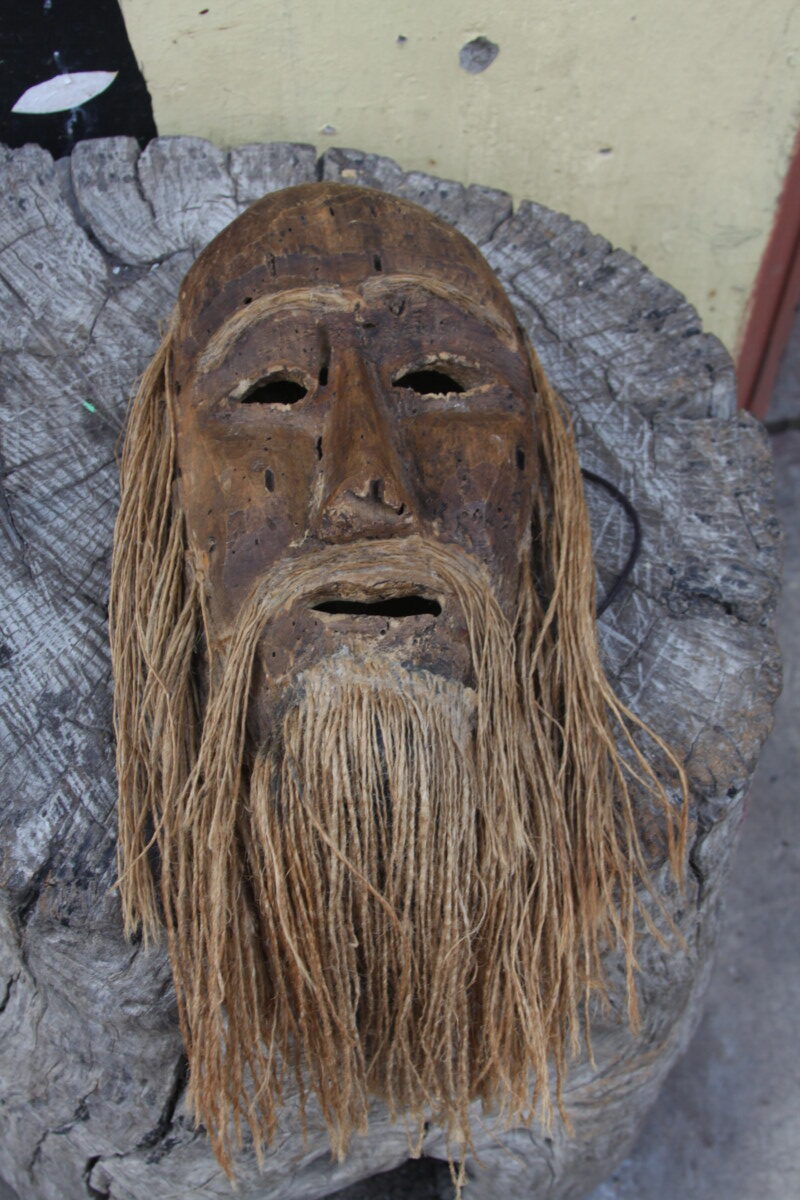
The first mask made by José de Jesús Romero Pérez was of a hermit in copal wood. photo by: María del Refugio Reynozo Medina
Behind the masks of tough men or picturesque red-cheeked women are the Romero Perez brothers. They appear in the parades and processions so that the legendary figures of the sayacos do not die and because Abel says «behind the wooden masks is the inner child.»
Translated by Nita Rudy
Lake Chapala Educational website launched
The portal contains fact sheets about the fauna present at Lake Chapala, one of them being the American White Pelican. Photo: Farid Bak.
Editor.- The Program “Bosques+Agua+Gente para Chapala” (Forests+ Water+ People of Chapala) has created a website about Lake Chapala and its environmental importance to the region.
The website’s goal is to inform the public about the wonders of, and challenges to, the Lake Chapala basin. This digital space presents clear, organized and solidly sourced information, aimed both at the public of the Lake Chapala shore, as well as those of the Guadalajara Metropolitan Area (ZMG).
The website discusses in detail the biological heritage of Lake Chapala. Information and photos are listed about the unique birds, animals, reptiles, fish and mammals found in the region. Another area of the website discusses the value of vegetation, forests, mountains and groundwater. A chart of the 19 problems that affect the world’s lakes has been posted. The 15 problems present in the Chapala basin are discussed in detail. There is a map of the region listing the current projects addressing environmental concerns.
This website is part of a program to conserve the beauty and natural wealth of the lake. It will be an important, informative platform for anyone who loves or lives at Lakeside.
It is funded by the Fondo Mexicano Para Conservacíon de La Naturaleza, A.C; Rio Arronte Fundación and the Corazone de La Tierra Institute de Desarrollo Ambiental.
The address for the website is www.lagodechapala.org. It is in Spanish only, but can be viewed in English with a Chrome browser and Google Translate plug-in.
Translated by Nita Rudy
Regresa el Carnaval al Pueblo Mágico de Ajijic
Las Sayacas bailaron e interactuaron con espectadores en múltiples ocasiones durante el recorrido.
Redacción.- Luego de un año de ausencia y por motivos de la pandemia, el carnaval regresó al Pueblo Mágico de Ajijic con todo su colorido, creatividad y tradición, por lo que Semanario Laguna te comparte una galería de imágenes de Sofía Medeles que muestran cómo han sido los primeros tres días del Carnaval que en ausencia de los carros alegóricos, las Sayacas y Sayacos se han lucido como nunca.

Cómo es tradición, decenas de jóvenes «cucaron» a las Sayacas con tal de que los «polvearan» con harina.

Desde el inicio hasta el fin del desfile, las Sayacas bailaron luciendo sus trajes multicolores.

Hay Sayacas que lucen coloridas faldas, son muy coquetas y se lucen bailando como las que se presentaron durante el tercer día de desfile.

Los y las jinetes también son parte importante para que un desfile sea tradicional.
El recibimiento y el desfile, los pilares del Carnaval de Ajijic
Ruedo ubicado a un costado de la plaza principal, donde se celebran las corridas de carnaval. Foto: Facebook.
Sofía Medeles-. Uno de los carnavales más antiguos del municipio de Chapala, es el de Ajijic, el cual, desde 1880, e incluso antes, ha unido a los pobladores, para festejar, adoptando en cada época nuevas costumbres, hasta llegar a lo que es actualmente.
Según el exdirector del Archivo Histórico de Chapala e investigador de la historia de Ajijic, Eduardo Ramos Cordero, el Martes de Carnaval era inicialmente un desfile para presentar a los charros y a los toros que participarían en la corrida llevada a cabo para el pueblo.

Petición del comisario Tomás Flores para realizar el Carnaval en Ajijic. Es un documento que data de 1880. Foto: Sofía Medeles.
En sus palabras, la formación del desfile era: sayacas tradicionales al frente, las cuales solían usar confeti, en muy pocas ocasiones harina, seguido de esto, los toros que se lidiarían en la corrida y en el toro de once, y detrás de ellos, los charros con su traje de gala. En cuanto al recibimiento, o refresco, mencionó que es mucho más antiguo.
El actual presidente de la Asociación de Charros, Ernesto Pérez Reyes, compartió que el recibimiento era una manera de agradecer y recibir a los ganaderos, que traían su ganado desde lejanas poblaciones a pie y atravesando las montañas. “Es una tradición longeva, se podría decir que tiene al menos 60 años. La Asociación de Charros, tiene su acta constitutiva desde 1980, y el recibimiento se hacía de antes”, comentó Pérez Reyes.
Este evento consiste en brindarles comida, bebida y entretenimiento musical a los ganaderos que prestan su ganado. La asociación es la que se encarga de organizar esta tradición, recibiendo donaciones. Inicialmente, era para los invitados, pero con el tiempo, la gente del pueblo decidió unirse. Aproximadamente en los años 70´s, fue cuando empezó a cambiar y asemejarse a lo que es actualmente.

Traje tradicional de sayaco con máscara de madera. Foto: Dane Strom.
El exdirector del Centro Cultural Ajijic (CCA), Alejandro Martínez, añadió que él, junto a Ricardo González, Anselmo Ávalos, entre otros jóvenes del pueblo, querían que a Ajijic se le empezara a reconocer, y una manera de lograrlo fue impulsando la figura de la sayaca, así como los festejos del carnaval.
“Antes el carnaval sólo se centraba en los charros, porque ellos son los que lo organizan, pero, en su tiempo colaboramos con ellos para que el carnaval fuera algo más grande e involucrara a toda la población. Fue cuando se introdujeron los carros alegóricos, las reinas de carnaval, y un sin número de cosas, siempre destacando la presencia de las sayacas, porque son un personaje muy nativo y único de Ajijic”, explicó Alejandro.
Acting delegate Maximiliano Macías Arceo gets the nod in local comments
Maximiliano Macías Arceo, acting Ajijic delegate. Photo: Sofía Medeles.
Sofía Medeles (Ajijic).- Semanario Laguna talked to a group of 29 Ajijic residents last week, and found that 17 of them expressed their approval for the current Acting Ajijic delegate, Maximiliano Macías Arceo. The conversations covered residents living between Six Corners, to the west of the town, and Flores Magón. Seminario Laguna interviewed 29 residents. The poll questions included:
1) Do you know the work of the delegate?
2) Do you like the way he has worked so far?
3) Do you think we need an election to choose a delegate?
Responding to the first two questions, only two people disapproved of his work and management. As for the elections, 17 people preferred that Macías Arceo remain in the post, while 12 people said there should be an official vote.
Don Pepe, who lives on Álvaro Obregón, commented that, although he thought Macías Arceo’s performance was good, he also thought an election would be fair, «if the people have other options, it would be fair and legal to hold a vote, so that everyone feels heard,» he said.
Another resident commented, «I like how the delegate has worked, the opportunities he gives, and the response his office has given to people who approach him asking for help. If there were an election, I am concerned that the person elected might not have as good a working relationship with the new administration in Chapala, and as a result, Ajijic might suffer. Or that the winner of the election might not work as hard.” We are fine with Max, and he is very supportive of the people,» commented another interviewee.
Eli, another respondent, believes that a vote is important. It is important that the delegate represents the different opinions of the population they represent. Although she thinks Macías Arceo does his job well, she would like to have the option to choose a delegate.
Gaby, another resident, offered a different perspective, «it is important to vote, but in this case, I do not see another person more suitable or apt to do the job that Max is doing. He has respond to several reports, regardless of the time, the place, or the person who is requesting. For example, the day the tree fell in the plaza, it was already about eleven o’clock at night; he and his wife were helping right away. Who else is going to offer that availability? The President will choose the best person for the job, but personally, I would like him to stay.»
Likewise, Adán added that he is very satisfied with the work. He believes Ajijic needs a proactive delegate. Previous ones have left much to be desired. «I don’t think an election is necessary since he has demonstrated that he can handle the position. It would be absurd to hold elections when we already have someone who has worked very well, and has demonstrated that he is up to the job.»
Municipal President, Alejandro de Jesús Aguirre Curiel stated that all current delegates will remain in place until the end of pandemic restrictions. This applies to the delegates of all five towns in the Chapala municipality: Ajijic, San Antonio Tlayacapan, Santa Cruz de la Soledad, San Nicolás de Ibarra and Atotonilquillo.
«As of October 1st, there will be office managers or delegados in each town, and as we go along, we will see about the election, depending on the work done by the office managers,» mentioned Aguirre Curiel before the start of his 2021-2024 administration.
During his previous administration, (2001-2004), it was stipulated in the Organic Government Regulations that it was essential to call for delegate elections during the first three months after the current administration started, however, with the changes made in 2018, there is now no specific deadline to call for elections.
Translated by Amy Esperanto
© 2016. Todos los derechos reservados. Semanario de la Ribera de Chapala
